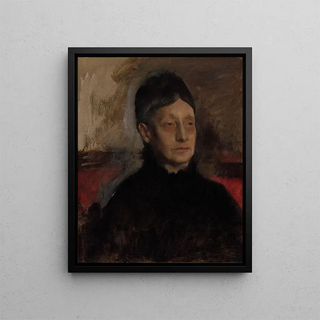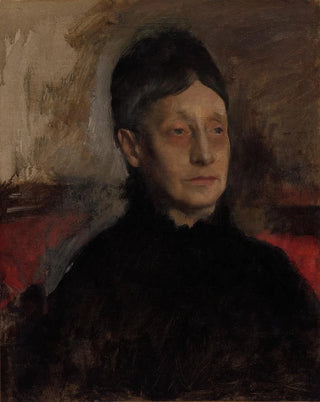Painting Stefanina Primicile Carafa, Marquise de Cicerale and Duchess of Montejasi - Edgar Degas | Art print


View from behind

Frame (optional)
In the fascinating universe of art, some works transcend the simple status of paintings to become witnesses of the era and society in which they were born. The art print of Stefanina Primicile Carafa, marquise de Cicerale and duchess of Montejasi, created by Edgar Degas, perfectly fits this tradition. This portrait, capturing the elegance and dignity of a woman from high society in the 19th century, immerses us in a world where beauty and refinement are omnipresent. Through Degas's eyes, the viewer is invited to discover not only the face of the marquise but also the soul of a time when art and life are intertwined inseparably.
Style and uniqueness of the work
Degas's style is immediately recognizable, oscillating between realism and impressionism. In this portrait, he manages to capture the personality of Stefanina Primicile Carafa with remarkable finesse. Soft colors and delicate nuances create an intimate atmosphere, while the carefully crafted composition highlights the natural grace of the duchess. Degas skillfully plays with light and shadow, emphasizing the delicate features of his model while giving her an almost ethereal aura. The marquise's posture, both majestic and approachable, reveals a deep understanding of the human psyche, a characteristic trait of the artist. This portrait does not merely depict an aristocratic figure; it evokes a story, a world of traditions and conventions, while also revealing a certain modernity.
The artist and his influence
Edgar Degas, an emblematic figure of the impressionist movement, distinguished himself through his unique approach to painting. Born in 1834, he dedicated his life to exploring themes of dance, theater, and daily life, while developing a personal style that combines meticulous observation and technical innovation. His ability to capture movement and life in all its diversity influenced many artists, both of his time and subsequent generations. In the portrait of Stefanina Primicile Carafa, Degas

Matte finish

View from behind

Frame (optional)
In the fascinating universe of art, some works transcend the simple status of paintings to become witnesses of the era and society in which they were born. The art print of Stefanina Primicile Carafa, marquise de Cicerale and duchess of Montejasi, created by Edgar Degas, perfectly fits this tradition. This portrait, capturing the elegance and dignity of a woman from high society in the 19th century, immerses us in a world where beauty and refinement are omnipresent. Through Degas's eyes, the viewer is invited to discover not only the face of the marquise but also the soul of a time when art and life are intertwined inseparably.
Style and uniqueness of the work
Degas's style is immediately recognizable, oscillating between realism and impressionism. In this portrait, he manages to capture the personality of Stefanina Primicile Carafa with remarkable finesse. Soft colors and delicate nuances create an intimate atmosphere, while the carefully crafted composition highlights the natural grace of the duchess. Degas skillfully plays with light and shadow, emphasizing the delicate features of his model while giving her an almost ethereal aura. The marquise's posture, both majestic and approachable, reveals a deep understanding of the human psyche, a characteristic trait of the artist. This portrait does not merely depict an aristocratic figure; it evokes a story, a world of traditions and conventions, while also revealing a certain modernity.
The artist and his influence
Edgar Degas, an emblematic figure of the impressionist movement, distinguished himself through his unique approach to painting. Born in 1834, he dedicated his life to exploring themes of dance, theater, and daily life, while developing a personal style that combines meticulous observation and technical innovation. His ability to capture movement and life in all its diversity influenced many artists, both of his time and subsequent generations. In the portrait of Stefanina Primicile Carafa, Degas
12,34 €






